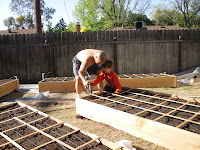Upsy Daisy...
 We have made a lot of progress over the past two weeks. The irrigation and SFG grids are in, most everything is planted, and next on the list is building upright supports for the tomato, pole beans, cucumbers, melons ans squash. It sounds a little strange to think of melons and squash growing upright, but that is one of the space saving strategies of a SFG. We'll see how it works. We do have to create some slings for the melons once they get big but other than that, training the vines to climb up is all there is too it.
We have made a lot of progress over the past two weeks. The irrigation and SFG grids are in, most everything is planted, and next on the list is building upright supports for the tomato, pole beans, cucumbers, melons ans squash. It sounds a little strange to think of melons and squash growing upright, but that is one of the space saving strategies of a SFG. We'll see how it works. We do have to create some slings for the melons once they get big but other than that, training the vines to climb up is all there is too it.We've had some hurdles with the irrigation system, and let's just say there are still some kinks to work out. It didn't work out like I imagined...an easy system of soaker hoses, perfectly timed, requiring only a leisurely hand watering here and there. NOPE! The yard slopes, causing flooding and the soakers don't get enough pressure to water even two boxes evenly. What we have now is one box on each system gets soaked and floods out the bottom, while the other is nearly dry. Seeing that a full irrigation tear out is not an option this year, it looks like we supplement by hand watering. The catch is that the garden isn't in our own backyard, this is going to require a bit of a commitment and some careful planning. Not ideal, but oh well.
So far most everything has been planted and is thriving. We already have had radishes, bush beans and squash sprout. This year I decided to start out with a few starter plants to get a rush on harvesting, since we sort of got a late start getting things in the ground. Hopefully this will give a few weeks staggered harvest, we'll see.
That is pretty much it for the garden update, but we have a few other things to share. We drove up to Penn Valley today to buy chickens from Brad and Alana Fowler at Fowler Family Farm http://fowlerfamilyfarm.com/3101.html. I can't even begin to tell you what nice people they were! They are a young family (3 daughters and now expecting TWINS!) who are not only incredibly knowledgeable, they really seem to care about what they do. We called up there today to find out if the chickens were available yet (the season is April - October), and they happen to be processing today, talk about fresh. So after visiting with them for an hour or so, exchanging stories and resources, we headed home with 20 chickens for our new freezer. Rick has promised Brad that he'll come up to help with the next processing day in 2 weeks so he should have some good stories to tell.
On another note, a new movie is coming out this June called Food,Inc. Here is some info about the movie that I found online and the link to watch the trailer. Should be very eye opening.
How much do we really know about the food we buy at our local supermarkets and serve to our families?http://takepart.com/foodinc/
In Food, Inc., filmmaker Robert Kenner lifts the veil on our nation's food industry, exposing the highly mechanized underbelly that's been hidden from the American consumer with the consent of our government's regulatory agencies, USDA and FDA. Our nation's food supply is now controlled by a handful of corporations that often put profit ahead of consumer health, the livelihood of the American farmer, the safety of workers and our own environment. We have bigger-breasted chickens, the perfect pork chop, insecticide-resistant soybean seeds, even tomatoes that won't go bad, but we also have new strains of e coli--the harmful bacteria that causes illness for an estimated 73,000 Americans annually. We are riddled with widespread obesity, particularly among children, and an epidemic level of diabetes among adults.
Featuring interviews with such experts as Eric Schlosser (Fast Food Nation), Michael Pollan (The Omnivore's Dilemma) along with forward thinking social entrepreneurs like Stonyfield Farm's Gary Hirshberg and Polyface Farms' Joel Salatin, Food, Inc. reveals surprising -- and often shocking truths -- about what we eat, how it's produced, who we have become as a nation and where we are going from here.






